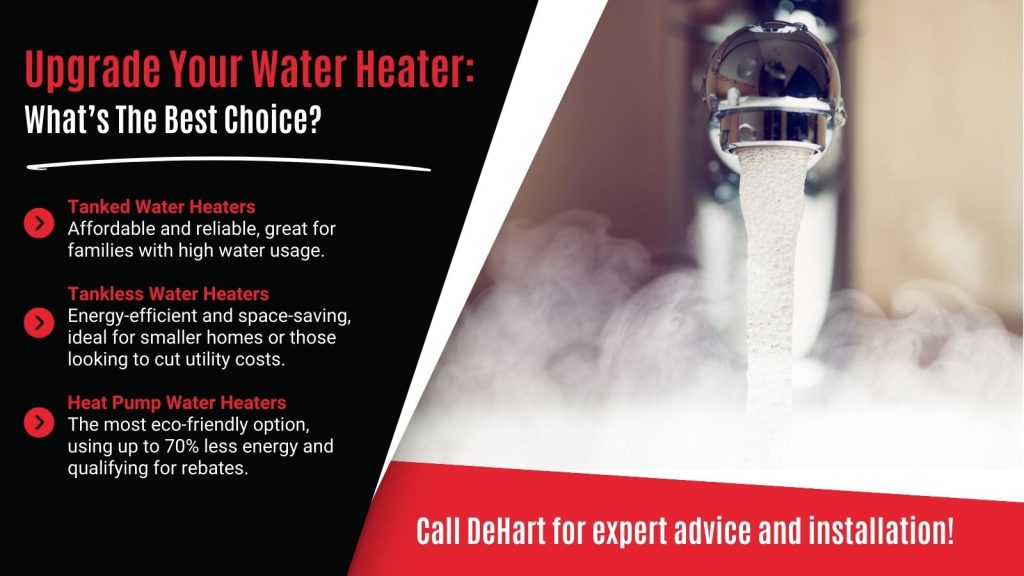When it comes to water heaters, homeowners have more options than ever before. Choosing the right water heater for your home can mean increased energy efficiency, lower utility bills, and enhanced comfort. In this blog, we’ll break down the three primary types of water heaters—tanked, tankless, and heat pump water heaters—highlight their benefits, and explain how each can serve your household needs.

Pros and Cons of Tanked Water Heaters
Tanked water heaters, also known as storage water heaters, are the most traditional option. These systems store heated water in a large tank, typically ranging in size from 30 to 80 gallons, and keep it hot and ready for use at all times.
Properly connecting the cold water supply during installation is crucial to ensure the system functions correctly and safely. After installation, turn the cold water supply ON and fill the tank to prepare the system for use.
Benefits of Tanked Water Heaters:
- Affordability: Tanked water heaters are often the most cost-effective option upfront, making them ideal for budget-conscious homeowners.
- Reliable Hot Water: These systems provide a steady supply of hot water, perfect for families with high water usage.
For homes in Oakdale, CA, tanked water heaters remain a practical choice, especially if energy efficiency isn’t the top priority.
Why Tankless Water Heaters Might Be Right for You
Tankless water heaters, or on-demand water heaters, heat water only when needed. Instead of storing hot water, they use powerful heating elements to provide hot water instantly as it flows through the system.
Benefits of Tankless Water Heaters:
- Energy Efficiency: By eliminating standby heat loss, tankless systems can significantly reduce energy consumption.
- Compact Design: These units take up much less space than their tanked counterparts, making them ideal for homes with limited room.
- Longevity: Tankless water heaters typically last longer, with an average lifespan of 20 years compared to 10–15 years for tanked systems.
Tankless water heaters are a great choice for homeowners looking to upgrade their systems. During a tankless water heater installation or replacement in Oakdale, CA, DeHart Plumbing, Heating, and Air Inc. offers both efficiency and convenience.
Exploring Heat Pump Water Heater Benefits
Heat pump water heaters are the most energy-efficient option on the market. Instead of generating heat directly, they use electricity to transfer heat from the surrounding air into the water tank, making them an environmentally friendly choice.
Benefits of Heat Pump Water Heaters:
- Energy Savings: These systems can use up to 70% less energy than traditional electric water heaters, which can lead to significant savings on utility bills.
- Rebates Available: Many homeowners can qualify for rebates of up to $2,000, making heat pump water heaters an even more attractive option.
- Eco-Friendly: By reducing energy consumption, heat pump water heaters help lower your carbon footprint.
If you’re looking for an energy-efficient solution to heat water in your home, a heat pump water heater is an excellent investment that pays off in both cost savings and environmental benefits.
Key Components of Water Heaters
Pressure Relief Valve
A pressure relief valve is a critical component of a water heater that helps to prevent excessive pressure buildup inside the tank. This valve is designed to release excess pressure and prevent the tank from rupturing, which can lead to serious injury or property damage. The pressure relief valve is typically located on the side or top of the water heater and is connected to a discharge pipe that directs the released water to a safe location.
Drain Pan and Discharge Pipe
A drain pan is a shallow pan that is installed under the water heater to catch any water that may leak from the tank or pipes. The drain pan is connected to a discharge pipe that directs the water to a safe location, such as a floor drain or outside. The drain pan and discharge pipe are essential components of a water heater installation, as they help to prevent water damage and ensure safe operation.
Pre-Installation Considerations
Choosing the Right Water Heater
Choosing the right water heater for your home is crucial to ensure efficient and safe operation. Start by assessing your household’s hot water needs. For instance, tankless water heaters are ideal for homes with limited space and high hot water demands, as they provide hot water on demand without the need for a bulky storage tank. On the other hand, electric water heaters are suitable for homes with access to electricity and lower hot water needs, offering a reliable and straightforward solution.
Space availability is another critical factor. Tankless water heaters take up much less room compared to traditional tanked models, making them perfect for smaller homes or apartments. Energy efficiency should also be a key consideration. Heat pump water heaters, for example, are highly energy-efficient and can significantly reduce your utility bills.
Consulting with a professional can help you determine the best water heater for your specific needs, ensuring you make an informed decision that balances performance, cost, and efficiency.
Shutting Off the Power and Water Supply
Before starting the installation process, it’s crucial to shut off the power and water supply to the water heater. Begin by locating the circuit breaker or fuse that controls the water heater and switch it off to cut the power. This step is essential to prevent any electrical accidents during the installation.
Next, find the shut-off valves for the cold water supply. These are typically located near the water heater. Turn the valves clockwise to shut off the water supply. To ensure the system is fully drained, open a hot water faucet and let the water run until it stops. This will drain the remaining water from the pipes and the tank, making it safe to proceed with the installation.
Installation Considerations
When planning a water heater installation, several factors need to be considered to ensure optimal performance and safety. First, assess the space where the water heater will be installed. Tankless water heaters require less space compared to tanked models, making them ideal for smaller areas. Next, consider the energy source—whether you opt for a gas, electric, or heat pump water heater will impact both installation and operating costs. Additionally, local building codes and regulations must be followed to ensure compliance and safety. Finally, factor in the water heater installation cost, which can vary based on the type of water heater and the complexity of the installation. Proper planning and professional installation can help avoid future water heater repairs and ensure a reliable supply of hot water for your home. Always read all printed installation instructions and safety warnings before beginning the installation process.
Connecting the Water Supply
Connecting the water supply to the new water heater requires careful attention to detail. Start by ensuring that the water supply lines are properly sized and configured to match the new water heater’s requirements. This is crucial for optimal performance and safety.
Use a thermostatic mixing valve to regulate the water temperature and prevent scalding. This valve mixes hot and cold water to deliver water at a safe temperature, protecting your household from burns.
Connect the cold water supply line to the inlet connection on the water heater marked “C” (COLD). Ensure the connection is secure and sealed using pipe joint compound or plumber’s tape. Next, connect the hot water supply line to the outlet connection marked “H” (HOT). Again, use pipe joint compound or plumber’s tape to ensure a tight seal. Properly connecting these lines is essential to prevent leaks and ensure the system functions correctly.
Final Checks
Testing the System
After completing the installation, it’s essential to test the system to ensure it’s working correctly. Start by turning on the power and water supply to the water heater. Check for any leaks or water damage around the connections and the tank.
Next, test the hot water faucet to ensure it’s producing hot water at the correct temperature. This step verifies that the heating elements are functioning properly and that the water temperature is regulated correctly.
Check the pressure relief valve to ensure it’s functioning correctly. This valve is a critical safety feature that prevents excessive pressure buildup inside the tank. Lift the valve’s lever to release some water and ensure it closes properly without leaking.
Finally, inspect the drain pan and discharge pipe to ensure they’re properly installed and functioning correctly. The drain pan should be positioned to catch any potential leaks, and the discharge pipe should direct water to a safe location, preventing water damage to your home.
By following these steps, you can ensure your new water heater is installed correctly and safely, providing reliable hot water for your household.
How to Select the Best Water Heater Type for Your Needs
Selecting the right water heater depends on your household’s hot water needs, budget, and long-term goals. Whether you’re looking to replace an aging hot water heater, upgrade to a sleek tankless model, or invest in an energy-efficient heat pump water heater, DeHart Plumbing, Heating, and Air Inc. is here to help.












